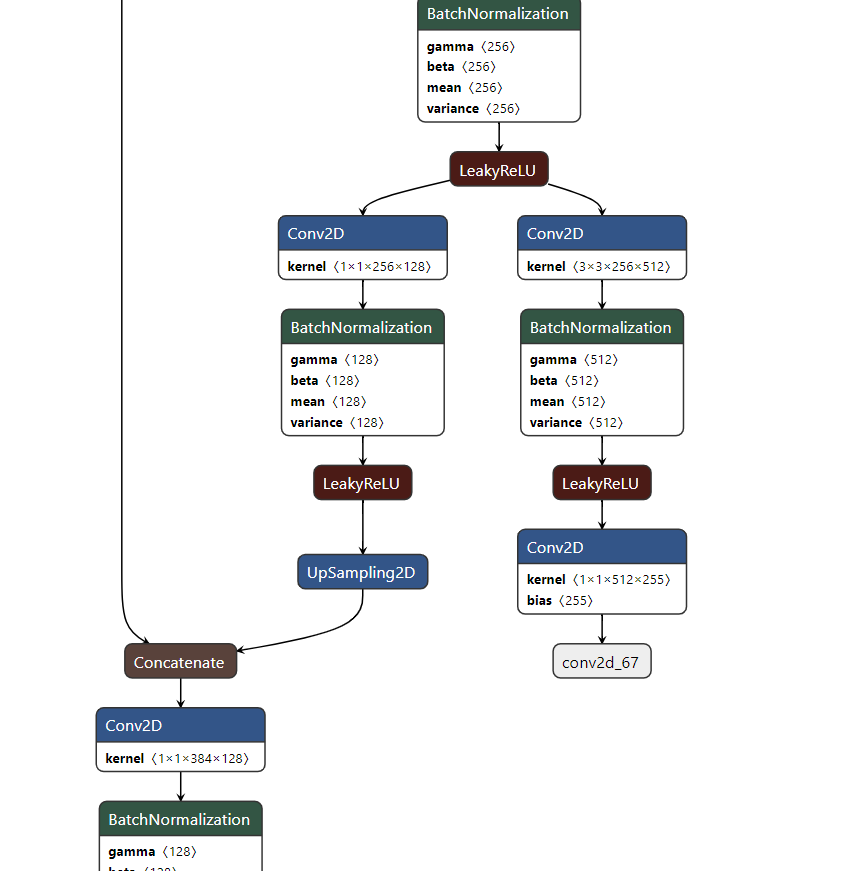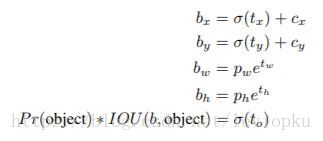YOLOV3算法详解
YOLOV3
YOLO3主要的改进有:调整了网络结构;利用多尺度特征进行对象检测;对象分类用Logistic取代了softmax。
新的网络结构Darknet -53
darknet-53借用了resnet的思想,在网络中加入了残差模块,这样有利于解决深层次网络的梯度问题,每个残差模块由两个卷积层和一个shortcut connections,
1,2,8,8,4代表有几个重复的残差模块,整个v3结构里面,没有池化层和全连接层,网络的下采样是通过设置卷积的stride为2来达到的,每当通过这个卷积层之后
图像的尺寸就会减小到一半。而每个卷积层的实现又是包含 卷积+BN+Leaky relu ,每个残差模块之后又要加上一个zero padding,具体实现可以参考下面的一张图。
论文中所给的网络结构如下,由卷积模块和残差模块组成;

模型可视化
具体的全部模型结构可以从这个网站的工具进行可视化分析:
https://lutzroeder.github.io/netron/
从Yolo的官网上下载yolov3的权重文件,然后通过官网上的指导转化为H5文件,然后可以再这个浏览器工具里直接看yolov3的每一层是如何分布的;类似下边截图是一部分网络(最后的拼接部分);

整体来看Yolov3的输入与输出形式如下:
输入416*416*3的图像,通过darknet网络得到三种不同尺度的预测结果,每个尺度都对应N个通道,包含着预测的信息;
每个网格每个尺寸的anchors的预测结果。
对比下yolov1,有7*7*2个预测;
对比下yolov2,有13*13*5个预测;
YOLOv3共有13*13*3 + 26*26*3 + 52*52*3个预测 。
每个预测对应85维,分别是4(坐标值)、1(置信度分数)、80(coco类别数)

多尺度检测:
对于多尺度检测来说,采用多个尺度进行预测,具体形式是在网络预测的最后某些层进行上采样拼接的操作来达到;对于分辨率对预测的影响如下解释:
分辨率信息直接反映的就是构成object的像素的数量。一个object,像素数量越多,它对object的细节表现就越丰富越具体,也就是说分辨率信息越丰富。这也就是为什么大尺度feature map提供的是分辨率信息了。语义信息在目标检测中指的是让object区分于背景的信息,即语义信息是让你知道这个是object,其余是背景。在不同类别中语义信息并不需要很多细节信息,分辨率信息大,反而会降低语义信息,因此小尺度feature map在提供必要的分辨率信息下语义信息会提供的更好。(而对于小目标,小尺度feature map无法提供必要的分辨率信息,所以还需结合大尺度的feature map)

YOLO3更进一步采用了3个不同尺度的特征图来进行对象检测。能够检测的到更加细粒度的特征。
对于这三种检测的结果并不是同样的东西,这里的粗略理解是不同给的尺度检测不同大小的物体。
网络的最终输出有3个尺度分别为1/32,1/16,1/8;
在第79层之后经过几个卷积操作得到的是1/32 (13*13) 的预测结果,下采样倍数高,这里特征图的感受野比较大,因此适合检测图像中尺寸比较大的对象。
然后这个结果通过上采样与第61层的结果进行concat,再经过几个卷积操作得到1/16的预测结果;它具有中等尺度的感受野,适合检测中等尺度的对象。
91层的结果经过上采样之后在于第36层的结果进行concat,经过几个卷积操作之后得到的是1/8的结果,它的感受野最小,适合检测小尺寸的对象。
concat:张量拼接。将darknet中间层和后面的某一层的上采样进行拼接。拼接的操作和残差层add的操作是不一样的,拼接会扩充张量的维度,而add只是直接相加不会导致张量维度的改变。
使用Kmeans聚类的方法来决定anchors的尺寸大小:
logistic回归用于对anchor包围的部分进行一个目标性评分(objectness score),(用于NMS),即这块位置是目标的可能性有多大。
公式一:

yolo_v3只会对1个prior进行操作,也就是那个最佳prior。而logistic回归就是用来从9个anchor priors中找到objectness score(目标存在可能性得分)最高的那一个。
对象分类softmax改成logistic
预测对象类别时不使用softmax,改成使用logistic的输出进行预测。这样能够支持多标签对象(比如一个人有Woman 和 Person两个标签)。
YOLO的LOSS函数:
1 # K.binary_crossentropy is helpful to avoid exp overflow.
2 xy_loss = object_mask * box_loss_scale * K.binary_crossentropy(raw_true_xy, raw_pred[...,0:2], from_logits=True)
3 wh_loss = object_mask * box_loss_scale * 0.5 * K.square(raw_true_wh-raw_pred[...,2:4])
4 confidence_loss = object_mask * K.binary_crossentropy(object_mask, raw_pred[...,4:5], from_logits=True)+ \
5 (1-object_mask) * K.binary_crossentropy(object_mask, raw_pred[...,4:5], from_logits=True) * ignore_mask
6 class_loss = object_mask * K.binary_crossentropy(true_class_probs, raw_pred[...,5:], from_logits=True)
7
8 xy_loss = K.sum(xy_loss) / mf
9 wh_loss = K.sum(wh_loss) / mf
10 confidence_loss = K.sum(confidence_loss) / mf
11 class_loss = K.sum(class_loss) / mf
12 loss += xy_loss + wh_loss + confidence_loss + class_loss
13 if print_loss:
14 loss = tf.Print(loss, [loss, xy_loss, wh_loss, confidence_loss, class_loss, K.sum(ignore_mask)], message='loss: ')
15 return loss
yolov3再keras中定义的Loss函数如上,基本可以看出,对于回归预测的部分是采用多个mse均方差相加来进行的(类似于上边所提到的v1中的Loss函数),对于分类部分和置信度是采用K.binary_crossentropy来进行的,最后把两种Loss相加得出最终的loss
部分源码分析:
1 def yolo_eval(yolo_outputs, 2 anchors, 3 num_classes, 4 image_shape, 5 max_boxes=20, 6 score_threshold=.6, 7 iou_threshold=.5): 8 """Evaluate YOLO model on given input and return filtered boxes."""
'''此函数的作用是对于Yolo模型的输出进行筛选,通过yolo_boxes_and_scores来给yolo_outputs打分,
然后通过(box_scores >= score_threshold)来初步把分数较低的预测去掉,再通过NMS操作对每个对象的anchors进行筛选,最终为每个对象得出一个分数最大且不重复的预测结果。'''
9 num_layers = len(yolo_outputs) 10 anchor_mask = [[6,7,8], [3,4,5], [0,1,2]] if num_layers==3 else [[3,4,5], [1,2,3]] # default setting 11 input_shape = K.shape(yolo_outputs[0])[1:3] * 32 12 boxes = [] 13 box_scores = [] 14 for l in range(num_layers): 15 _boxes, _box_scores = yolo_boxes_and_scores(yolo_outputs[l], 16 anchors[anchor_mask[l]], num_classes, input_shape, image_shape) 17 boxes.append(_boxes) 18 box_scores.append(_box_scores) 19 boxes = K.concatenate(boxes, axis=0) 20 box_scores = K.concatenate(box_scores, axis=0) 21 22 mask = box_scores >= score_threshold
'''设定分数的阈值''' 23 max_boxes_tensor = K.constant(max_boxes, dtype='int32') 24 boxes_ = [] 25 scores_ = [] 26 classes_ = [] 27 for c in range(num_classes): 28 # TODO: use keras backend instead of tf. 29 class_boxes = tf.boolean_mask(boxes, mask[:, c]) 30 class_box_scores = tf.boolean_mask(box_scores[:, c], mask[:, c]) 31 nms_index = tf.image.non_max_suppression( 32 class_boxes, class_box_scores, max_boxes_tensor, iou_threshold=iou_threshold)
'''进行NMS非极大值抑制操作,设置iou_threshold,筛选得出最佳结果; 这里使用的是tensorflow自带的nms方法,pytorch中一般都是自定义的nms''' 33 class_boxes = K.gather(class_boxes, nms_index) 34 class_box_scores = K.gather(class_box_scores, nms_index) 35 classes = K.ones_like(class_box_scores, 'int32') * c 36 boxes_.append(class_boxes) 37 scores_.append(class_box_scores) 38 classes_.append(classes) 39 boxes_ = K.concatenate(boxes_, axis=0) 40 scores_ = K.concatenate(scores_, axis=0) 41 classes_ = K.concatenate(classes_, axis=0) 42 43 return boxes_, scores_, classes_
下面这个函数是加载模型调用上面的yolo_eval函数产生boxes,scores,classes:
1 def generate(self): 2 model_path = os.path.expanduser(self.model_path) 3 assert model_path.endswith('.h5'), 'Keras model or weights must be a .h5 file.' 4 5 # Load model, or construct model and load weights. 6 num_anchors = len(self.anchors) 7 num_classes = len(self.class_names) 8 is_tiny_version = num_anchors==6 # default setting 9 try: 10 self.yolo_model = load_model(model_path, compile=False) 11 except: 12 self.yolo_model = tiny_yolo_body(Input(shape=(None,None,3)), num_anchors//2, num_classes) \ 13 if is_tiny_version else yolo_body(Input(shape=(None,None,3)), num_anchors//3, num_classes) 14 self.yolo_model.load_weights(self.model_path) # make sure model, anchors and classes match 15 else: 16 assert self.yolo_model.layers[-1].output_shape[-1] == \ 17 num_anchors/len(self.yolo_model.output) * (num_classes + 5), \ 18 'Mismatch between model and given anchor and class sizes' 19 20 print('{} model, anchors, and classes loaded.'.format(model_path)) 21 22 # Generate colors for drawing bounding boxes. 23 hsv_tuples = [(x / len(self.class_names), 1., 1.) 24 for x in range(len(self.class_names))] 25 self.colors = list(map(lambda x: colorsys.hsv_to_rgb(*x), hsv_tuples)) 26 self.colors = list( 27 map(lambda x: (int(x[0] * 255), int(x[1] * 255), int(x[2] * 255)), 28 self.colors)) 29 np.random.seed(10101) # Fixed seed for consistent colors across runs. 30 np.random.shuffle(self.colors) # Shuffle colors to decorrelate adjacent classes. 31 np.random.seed(None) # Reset seed to default. 32 33 # Generate output tensor targets for filtered bounding boxes. 34 self.input_image_shape = K.placeholder(shape=(2, )) 35 if self.gpu_num>=2: 36 self.yolo_model = multi_gpu_model(self.yolo_model, gpus=self.gpu_num) 37 boxes, scores, classes = yolo_eval(self.yolo_model.output, self.anchors, 38 len(self.class_names), self.input_image_shape, 39 score_threshold=self.score, iou_threshold=self.iou) 40 return boxes, scores, classes
our system only assigns one bounding box prior for each ground truth object.论文原话,v3预测bbox只预测一个最准确的;在训练过程中yolov3是预测9个anchors的,对于loss的计算是找到iou最大的哪个,但是预测的时候只选一个最精确的。
1 def preprocess_true_boxes(true_boxes, input_shape, anchors, num_classes): 2 '''Preprocess true boxes to training input format 3 4 Parameters 5 ---------- 6 true_boxes: array, shape=(m, T, 5) 7 Absolute x_min, y_min, x_max, y_max, class_id relative to input_shape. 8 input_shape: array-like, hw, multiples of 32 9 anchors: array, shape=(N, 2), wh 10 num_classes: integer 11 12 Returns 13 ------- 14 y_true: list of array, shape like yolo_outputs, xywh are reletive value 15 16 ''' 17 assert (true_boxes[..., 4]<num_classes).all(), 'class id must be less than num_classes' 18 num_layers = len(anchors)//3 # default setting 19 anchor_mask = [[6,7,8], [3,4,5], [0,1,2]] if num_layers==3 else [[3,4,5], [1,2,3]] 20 21 true_boxes = np.array(true_boxes, dtype='float32') 22 input_shape = np.array(input_shape, dtype='int32') 23 boxes_xy = (true_boxes[..., 0:2] + true_boxes[..., 2:4]) // 2 24 boxes_wh = true_boxes[..., 2:4] - true_boxes[..., 0:2] 25 true_boxes[..., 0:2] = boxes_xy/input_shape[::-1] 26 true_boxes[..., 2:4] = boxes_wh/input_shape[::-1] 27 28 m = true_boxes.shape[0] 29 grid_shapes = [input_shape//{0:32, 1:16, 2:8}[l] for l in range(num_layers)] 30 y_true = [np.zeros((m,grid_shapes[l][0],grid_shapes[l][1],len(anchor_mask[l]),5+num_classes), 31 dtype='float32') for l in range(num_layers)] 32 33 # Expand dim to apply broadcasting. 34 anchors = np.expand_dims(anchors, 0) 35 anchor_maxes = anchors / 2. 36 anchor_mins = -anchor_maxes 37 valid_mask = boxes_wh[..., 0]>0 38 39 for b in range(m): 40 # Discard zero rows. 41 wh = boxes_wh[b, valid_mask[b]] 42 if len(wh)==0: continue 43 # Expand dim to apply broadcasting. 44 wh = np.expand_dims(wh, -2) 45 box_maxes = wh / 2. 46 box_mins = -box_maxes 47 48 intersect_mins = np.maximum(box_mins, anchor_mins) 49 intersect_maxes = np.minimum(box_maxes, anchor_maxes) 50 intersect_wh = np.maximum(intersect_maxes - intersect_mins, 0.) 51 intersect_area = intersect_wh[..., 0] * intersect_wh[..., 1] 52 box_area = wh[..., 0] * wh[..., 1] 53 anchor_area = anchors[..., 0] * anchors[..., 1] 54 iou = intersect_area / (box_area + anchor_area - intersect_area) 55 56 # Find best anchor for each true box 57 best_anchor = np.argmax(iou, axis=-1) 58 '''获取最大Iou的那个anchor''' 59 for t, n in enumerate(best_anchor): 60 for l in range(num_layers): 61 if n in anchor_mask[l]: 62 i = np.floor(true_boxes[b,t,0]*grid_shapes[l][1]).astype('int32') 63 j = np.floor(true_boxes[b,t,1]*grid_shapes[l][0]).astype('int32') 64 k = anchor_mask[l].index(n) 65 c = true_boxes[b,t, 4].astype('int32') 66 y_true[l][b, j, i, k, 0:4] = true_boxes[b,t, 0:4] 67 y_true[l][b, j, i, k, 4] = 1 68 y_true[l][b, j, i, k, 5+c] = 1 69 70 return y_true



